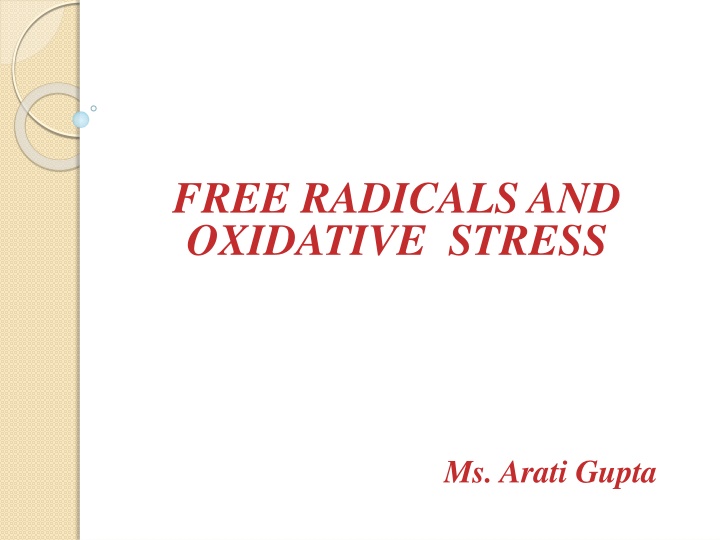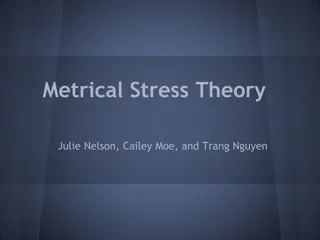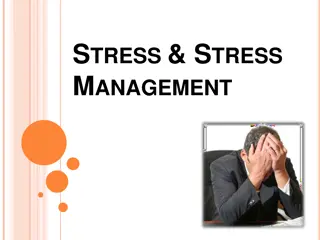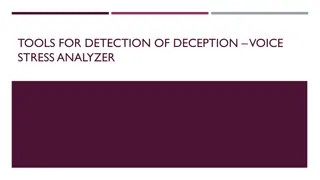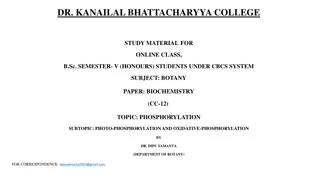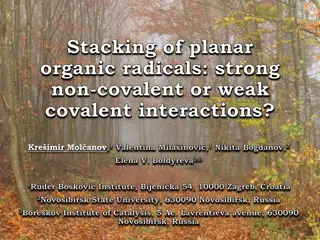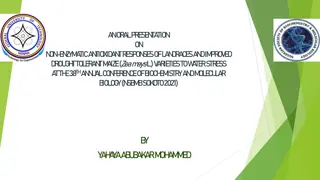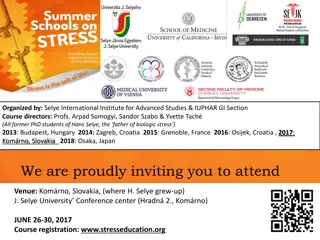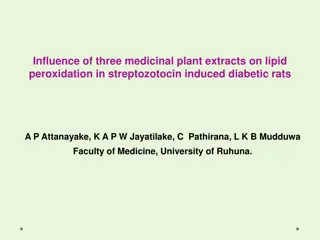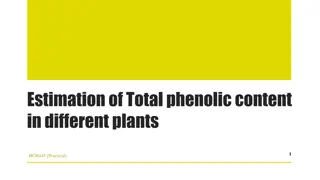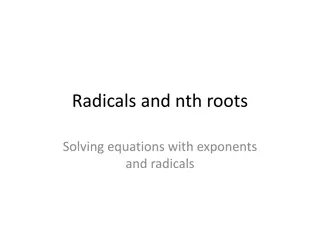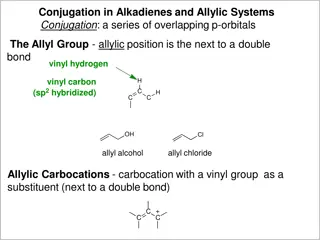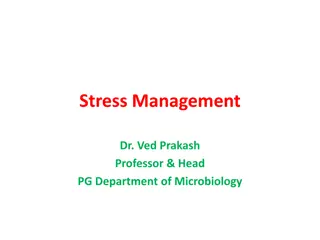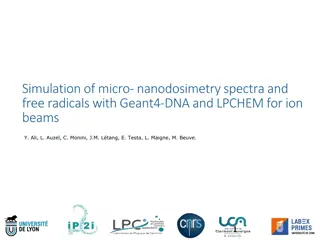Free Radicals and Oxidative Stress: Understanding the Impact
Free radicals, with their unpaired electrons, play a crucial role in various biochemical activities but also contribute to oxidative stress. Disruption in the balance between free radicals and antioxidants can lead to cell damage and several diseases. Learn about the chemistry of free radicals, how they are formed, and the implications of their excess in biological systems.
Download Presentation

Please find below an Image/Link to download the presentation.
The content on the website is provided AS IS for your information and personal use only. It may not be sold, licensed, or shared on other websites without obtaining consent from the author.If you encounter any issues during the download, it is possible that the publisher has removed the file from their server.
You are allowed to download the files provided on this website for personal or commercial use, subject to the condition that they are used lawfully. All files are the property of their respective owners.
The content on the website is provided AS IS for your information and personal use only. It may not be sold, licensed, or shared on other websites without obtaining consent from the author.
E N D
Presentation Transcript
FREE RADICALS AND OXIDATIVE STRESS Ms. Arati Gupta
Introduction A Free radicals contains one or more unpaired electrons in its outer orbital. is a molecule or molecular fragment that Free radical is generally represented by a superscript dot, ( ). They participate in many physiological and biochemical activities such as the immune response, metabolism of unsaturated fatty acids, and inflammatory reaction. The products of partial reduction of oxygen are highly reactive, called Reactive oxygen species or ROS. Not all reactive oxygen species are free radicals, e.g. singlet oxygen and hydrogen peroxide.
Free Radicals Superoxide anion radical (O2 - ) Hydroperoxyl radical (HOO ) Hydroxyl radical (OH ) Lipid peroxide radical (ROO ) Nitric oxide (NO ) Peroxy nitrite (ONOO- ). The balance between free radicals and antioxidants is disrupted in many diseases.
Introduction This disruption may be attributed to a number of factors . the inability of the cells to produce sufficient amounts of antioxidants the excessproduction of reactive oxygen species
Introduction Free radical excess results in impairment of 1. DNA 2. Enzymes 3. Membranes Induces changes in the activity of the immune system and in the structure of basic biopolymers Which is related to mutagenesis and aging processes.
FREE RADICAL CHEMISTRY As free radical contains an odd number of electron, which make it unstable. It can react quickly with other compound, trying to capture the needed electron to gain stability. Generally, free radical attacks the nearest stable molecule" stealing" its electron. When the attacked molecule loses its electron, it becomes a free radical itself, beginning a chain reaction cascade resulting in disruption of a living cell.
HOW FREE RADICALS ARE FORMED? A) Covalent bond cleavage of normal molecule or atom: Atoms are blinded together when they share or transfer electron to form molecule. A covalent bond is formed when a pair of electron is shared.
HOW FREE RADICALS ARE FORMED ? The formation of radicals may involve breaking of covalent bonds homolytically, a process that requires significant amounts of energy. Hemolytic cleavage in this type of cleavage both atoms retain one electron each due to symmetrical rupture of bond. H-H H + H Such type of cleavage requires high energy input either in the form of high temperature, U.V light or ionizing radiation to cause hemolysis of covalent bond.
HOW FREE RADICALS ARE FORMED? B) Electron transfer: Electron transfer is a far more common an important source of generation of free radicals in biological system. i)Oxidation reaction: By loss of a single electron from a normal molecule. ii)Reduction reaction: By addition of a single electron to a normal molecule H-H H + H+
SOURCES OF FREE RADICAL The most important free radicals in biological system are radical derivatives of oxygen. (Reactive oxygen species ) ROS includes free radical as well as other non-radical derivatives of oxygen e.g. H, O & Singlet Oxygen. These ROS can produce oxidative damage to the tissue and hence are known as oxidants in biological system.
SOURCES OF FREE RADICAL There are two important sources of reactive oxygen species generation in the biological system:
Generation of Free Radicals Endogenous Production of ROS Xanthine oxidase, which catalyzed hypoxanthine to uric acid in the catabolism of purine nucleotide, generates superoxide during reduction of dioxygen. Cytochrome P450 enzyme complex found in endoplasmic reticulum, hydroxylation of endogenous and exogenous molecule generates superoxide as an intermediate. During prostaglandin synthesis, the reaction catalyzed by cyclooxygenase and lipooxygenase leads to the formation of hydroxyl and peroxyl radicals. responsible for the
Production of nitric oxide from various cells, by a reaction catalyzed by nitric oxide synthase. During phagocytosis of foreign particles, such as bacteria, the phagocytosis cells are activated and exhibit a rapid increase in oxygen consumption known as respiratory brust and leads to production of large amount of superoxide. - NADPH oxidase located in plasma membrane is responsible for the respiratory burst. - NADPH oxidase is inactive in resting phagocytic cell. - During phagocytosis, NADPH oxidase converts molecular oxygen from the surrounding tissue into superoxide.
- Superoxide is converted into hydrogen peroxide by superoxide dimutase (SOD). - Myeloperoxide ( MPO ), a lysosomal enzymes present within the phagolysosome, peroxide plus Chloride ion are converted into hypochlorous acid (HOCL ) that kills the bacteria. - H2O2 is either neutralized by catalase or glutathione peroxidase.
Exogenous cause of Formation of ROS Environmental factor are responsible for the generation of harmful free radicals. Result of drug metabolism. Cytochrome P450 related reactions. Due to damage caused by ionizing radiations on tissues (X-rays) Photolysis of O2 by light Photoexcitation of organic molecules Cigarette smoke Alcohol promotes lipid peroxidation.
Harmful Effects of free Radicals Proteins: Free radicals cause oxidation of sulfhydryl groups & modification of certain amino acids (e.g. methionine, cysteine, histidine, tryptophan). ROS may damage proteins by fragmentation, cross-linking & aggregation. Lipids: PUFA (Polyunsaturated fatty acids) present in the cell membrane are easily destroyed by peroxidation (Lipid peroxidation).
Lipid peroxidation Lipid peroxidation occurs in 3 stages- initiation, propagation & termination Initiation phase: -- This step involves the removal of hydrogen atom (H) from polyunsaturated fatty acids (RH), caused by hydroxyl radical. RH + OH0 R0 + H2O
Propagation phase: Under aerobic conditions, the fatty acid radical (R0) takes up oxygen to form peroxyradical (ROO0). The latter, in turn, can remove H-atom from another PUFA (RH) to form lipid hydroperoxide (ROOH). R0+ O2 ROO0 ROO0+ RH ROOH + R0
This lead to continue production of hydroperoxide with consumption of equimolecular quantities of PUFA. Termination: The reaction would proceed unchecked till a peroxyl radical reacts with another peroxyl radical to form inactive products. ROO0 + ROO0 RO---OR + O2 R0 + R0 R---R ROO0 + R0 RO---OR
Carbohydrates: Oxidation of monosaccharides (e .g. glucose) can produce H2O2 & oxoaldehyde. Glycation increases the susceptibility of proteins to the attack by free radicals. E.g. DM. Nucleic acids: Free radicals may cause DNA strand breaks, fragmentation of bases & deoxyribose.
Clinical Significance Chronic Inflammation Chronic inflammatory diseases such as rheumatoid arthritis are self-perpetuated by the free radicals released by neutrophils. ROS induced tissue damage appears to be involved in pathogenesis ulcerative colitis,chronic glomerulonephritis, etc. of chronic
Cardiovascular diseases (CVD): Oxidized low density lipoproteins (LDL), formed by the action of free radicals, promote atherosclerosis & CVD. Cancer: Free radicals damage DNA & cause mutagenicity and cytotoxicity & play a key role in carcinogenesis.
Respiratory diseases: Direct exposure of lungs to 100% oxygen for a long period is known to destroy endothelium & cause lung edema. This is mediated by free radicals. ROS are also responsible for adult respiratory distress syndrome (ARDS), a disorder characterized by pulmonary edema. In premature newborn infants, prolonged exposure to high oxygen concentrations is responsible for bronchopulmonary dysplasia.
Disease of Eye: Retrolental fibroplasia is a condition seen in premature infants treated with pure oxygen for a long time. It is cause by free radicals. Cataract: Increased exposure to oxidative stress contributes to cataract formation.
Aging process: Reactive oxygen metabolites (ROM) play a pivotal role in the degenerative brain disorders such as Parkinsonism, Alzheimer's dementia and multiple sclerosis. Cumulative effects of free radical injury cause gradual deterioration in aging process.
Oxidative stress An imbalance between the production of reactive species and antioxidant defense activity, and its enhanced state has been associated with many of the chronic diseases such neurodegenerative and cardiovascular diseases . as: cancer, diabetes,
The Effect of Oxidative stress Ratio between oxidized and reduce glutathione (2GSH/GSSG) is one determinant of oxidative stress in the body. of the important Higher production of ROS in the body may change DNA structure and result in modification of proteins and lipids, activation of several stress- induced transcription factors and production of proinflammatory and cytokines. anti-inflammatory
The Role of Oxidative stress in Pathogenesis DNA modification in oxidative stress lead to many pathphysiological condition in the body. Oxidative stress can lead to chronic inflammation which in turn could mediate most chronic disease including:- - cancer - diabetes mellitus - cardiovascular disorder - atherosclerosis - Neurological disorder - pulmonary disease - Autoimmune disease
Protect ourselves from free radical and long our life There are two techniques: 1. First, To maximizes antioxidant intake from foods and supplements. 2. second, To minimizes factors that promote the formation of free radicals. here are the basics: 1. Choose organic,additive-free foods. 2. Drink only purified water. 3. Avoid exposure to volatile chemicals. 4. Limit exposure to air pollution
Protect ourselves from free radical and long our life 5. limit the amount of time you spend in direct sunlight. 6. Check your house for radon gas. 7. Get medical and dental x-rays only when absolutelynecessary. 8. Take medications only when absolutely necessary. people with low intakes of antioxidant-rich fruits and vegetables were at greater risk for developing these chronic conditions than were people who ate plenty of these fruits and vegetables.
Protect ourselves from free radical and long our life Foods rich in antioxidants : 1. Berries: blueberries, cranberries and blackberries. 2. Carrots: Fresh, crisp carrots beta carotene. 3. Green Vegetables: Vegetables of all colors. 4. Grains: the immunity-boosting compounds. 5. Legumes: vitamin E 6. Green Tea: neutralize harmful free radicals.
